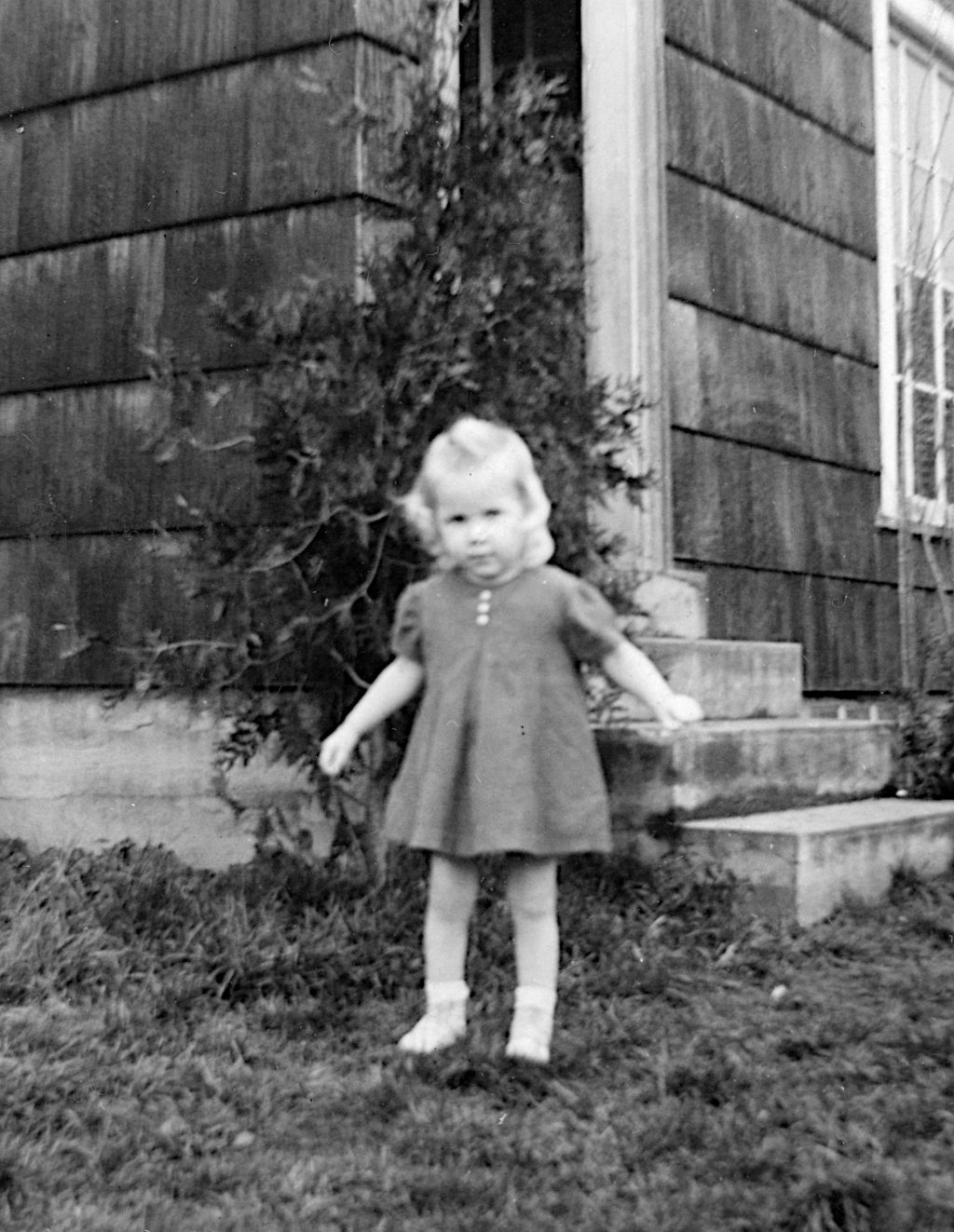Dorothy Wright was born in January 1942, the fifth child of Lloyd and Florence Wright. I imagine this photo was taken in the latter half of 1943, when Dorothy was between eighteen months and two years old.

The door behind Dorothy here is the front entrance to the Wright residence at 406 N Geary.
One thing about the Wright children, as you may have noticed, is that they all started out with very light blonde hair. “Towhead” was the term my father used for that, likening the color of the hair to the light yellow color of flax tow. (“Tow” was a term for coarse, broken fibers separated from finer fibers during processing of flax, hemp or jute.) In most cases the children’s hair didn’t stay that color, though.
Dorothy looks like she’s on a mission in this photo—going somewhere with determination and all the power her little body can generate.
No lack of cuteness, though.
I was, of course, born right after the beginning of WW2. At that time Earnestine Wood was the “ household help” whose husband was in the military. She used to say, according to Mom, that I was “half as high as a buttercup and twice as cute”!
Thanks for sharing this, Dorothy. I remember Mom quoting that phrase often (wish I’d remembered it last night when I was writing the post), but I don’t think I was ever aware of the source.
I heard at some point that Mom and Dad had taken in the Woods while he was stationed at Adair. But until you mentioned it, I wasn’t aware that her being “household help” was part of the arrangement.
Speaking of household help, the whole concept seems so foreign to my experience. Household help is what wealthy people had, and we most certainly weren’t that. So this succession of household help while the family lived in Albany (Viola Zehr, Verna Zeitler, now Earnestine Wood, and perhaps there were others) is not just a revelation to me, but a mind-blowing concept. Either the family was economically better off to a significant degree when Dad was an employee in Albany than when he had his own business in Junction City (which wouldn’t necessarily be surprising), or the economics of having household help fundamentally changed after the Depression and WWII (probably true, regardless).
Of course part of the reason this is foreign to my experience is that by the time I came along, Mom had built-in household help in the form of four teenage, or nearly teenage, daughters (soon reduced to three when Donna went off to college). But even without that, I can’t imagine Mom and Dad being able to afford to bring in household help—even on a “room, board and a small stipend” basis.
I can understand, Lloyd, that our household situation when we were little would seem very foreign to you, but that was the way it was! One of the “hired girls” was a mennonite who had a glass eye. I don’t remember her name, or even if she was one of the ones already named. I didn’t pay much attention to what went on around me, as everyone knows, but the household seemed to function quite well.
Life was very different because keeping a house was very different. No “labor saving devices” as we know them or “easy care fabrics “. Clothes were washed with a wringer washing machine, hung to dry outside or on a rack by the stove. Everything was ironed. Food cooked from scratch probably on a wood stove which had to be stoked. If you had 5 kids to care for that was a lot of work. So help was needed.. I remember when we got our first washing machine with no wringer when we lived in Junction City.
Thanks, Dorothy. Good points all. You’ve made the case for the necessity of household help, but I’m still curious how the economics of it changed after the Depression and WWII, that confined “household help” in general to the wealthy. Was it the movement of women into the workforce during the war that made better, higher-paying jobs available to young women and drove up wages to the point that middle class families couldn’t afford to hire household help? Was it government regulation of labor (wage-hour laws, income tax laws, etc., etc.) that made it impractical for most people to be employers? Something else? Likely some combination of factors. And of course the availability of labor-saving appliances at affordable prices (and the availability of electricity at affordable prices to run them), as you point out, moved household help from the “necessity” category to the “nice, but you can live without it” category. All very interesting.